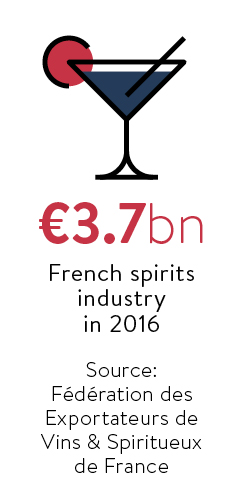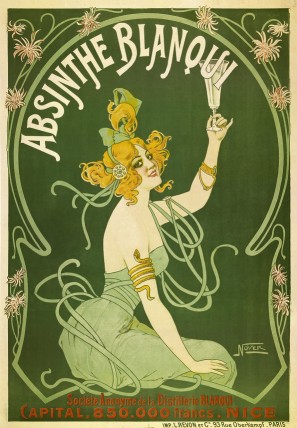Whether its spirits, vermouths, liqueurs or fortified wines, the French drinks cabinet is brimming with all manner of wonderful concoctions and each tells the story of a particular region or époque.
Made to drink on its own or in a cocktail, many of the brands that are now a staple of the world’s cocktail bars have been part of a growth in the value of the French spirits industry, with an increase in value of 13.2 per cent to €3.7 billion (£2.8 billion) compared with 2012.
Aperitifs
While wine has been a staple on dining tables across France for centuries, the story of many of its other drinks has been a more interesting journey. Time-worn adverts for Dubonnet, Lillet or Suze painted on the side of buildings as you drive through France, are a nod to the early years of the aperitif.
These fortified wines were originally developed as anti-malarial tonics for soldiers in the French foreign legion in the late 19th-century, which began a fashion for health tonics among the general public. This, in turn, paved the way for aperitifs to be drunk before meals to aid appetite and digestion.

Barrels at the Remy Martin distillery in Cognac
The custom of enjoying an aperitif spawned many different drinks including vermouths, such as Noilly Prat, and bi-products of other drinks, such as pineau de charentes (from cognac, in Poitou-Charentes) and pommeau (from calvados, made in Normandy), but perhaps the most widely known pre-dinner drink in France is a kir.
This simple cocktail of crème de cassis and white wine, usually aligoté or chardonnay, was made famous by post-war mayor of Dijon Felix Kir and is poured in homes and local restaurants across France. There are more than a dozen producers of crème de cassis in Burgundy, the largest being Lejay-Lagoutte in Dijon, which also produces other fruit liqueurs.
Foreign interest
 While a kir is undoubtedly popular, especially among the older generation, Lejay-Lagoutte’s biggest market is a surprising contrast. The company sells four million bottles of fruit liqueurs, more than three quarters of which is crème de cassis, to Japan each year. Managing director Olivier Melis explains: “Crème de cassis is very popular among young Japanese women, who drink it mixed with soda water, sparkling water or in tea. One product that is very in vogue is the Lejay Fruit Jar, which is a mix of Lejay cassis and fresh fruit juice.”
While a kir is undoubtedly popular, especially among the older generation, Lejay-Lagoutte’s biggest market is a surprising contrast. The company sells four million bottles of fruit liqueurs, more than three quarters of which is crème de cassis, to Japan each year. Managing director Olivier Melis explains: “Crème de cassis is very popular among young Japanese women, who drink it mixed with soda water, sparkling water or in tea. One product that is very in vogue is the Lejay Fruit Jar, which is a mix of Lejay cassis and fresh fruit juice.”
Another producer, who is also giving crème de cassis a new sophisticated image around the world, is Mickael Antolin, a young entrepreneur who has created an eponymous artisanal brand intended for the luxury market. Mr Antolin spent several years as a basketball scholar at college in California, but when injury prevented him pursuing the game professionally, the Dijon-born student turned to developing a business based around the product that is synonymous with his home town.
“Cassis is something that never grew in the US, neither the image of it, nor the way we use it. We’ve never done cassis in a different way,” he says. “So that’s why I’ve been working hard to create and promote this high-end product.”
The world’s biggest consumer of Bénédictine is a working men’s club in Burnley, Lancashire
His hard work is paying off as his brand of cassis, which has hints of vanilla and violet, is being served at formal dinners at the Palace of Monaco and is being stocked in the bars of luxury Paris hotels, such as The Peninsula and The Royal Monceau. In California, meanwhile, a number of A-list bars and restaurants, such as Spago and Viceroy L’Ermitage in Beverley Hills, and Melisse in Santa Monica, are stocking the cassis. His next step, he says, is to find a British importer to bring it to the cocktail bars of London.
[embed_related]
Bénédictine
Another brand that has been a staple in the French drinks cabinet for over a century is Bénédictine. This historic liqueur is a blend of 27 different plants and spices, including cloves and juniper, and is best known for its part in such cocktails as the Singapore Sling, Bobby Burns, and Milk and Honey.
The unique drink dates from long before mixologists were reaching for the famous brown bottle with its wax seal. Bénédictine began its story as a herbal elixir developed by 16th-century monks in Normandy. The recipe was lost during the French Revolution and, in 1863, wine merchant and art collector Alexandre Le Grand rediscovered the recipe among his collection of antique books. He then set about reconstructing the drink, which was and is still enjoyed as a digestif. The drink became so successful that Mr Le Grand built the extraordinary Bénédictine Palace at Fecamp in Normandy, where the drink is still made today.

Vintage wall advertisement in Rennes for French wine-based aperitif Dubonnet
Being a drink of Normandy provenance made it popular among the soldiers of the First World War and a curious legacy of this is that the world’s biggest consumer of the drink is a working men’s club in Burnley, Lancashire, where regulars get through some 1,000 bottles a year. Many of the members’ ancestors were drafted into the East Lancashire Regiment, which was posted to Normandy during the war, as Bénédictine’s brand ambassador Ludovic Miazga explains: “Back then it was drunk as a ‘bene and hot’, Bénédictine and hot water, sipped during the cold winter nights.”
The bar of the Burnley Miners Social Club has even given it a new appeal to younger members of the club by creating a “bene-bomb”, their own version of a Jagerbomb, by mixing it with an energy drink.
Like many French spirits and liqueurs, Bénédictine found its fans in late 19th-century prohibition-era New York and continues to be a favourite among mixologists. Mr Miazga says: “In the last 50 World Best Bars awards, almost 99 per cent of the establishments have our bottle on their back bars and are using it to create the classics, but also contemporary cocktail creations.”
The Green Fairy
A French drink that has a more infamous legacy is absinthe, which was known as The Green Fairy on account of the wisp of green smoke that results from water being dripped through a sugar cube on a percolated spoon and on to the liquid. As the favoured tipple of late-19th-century and early-20th-century Paris artists and writers, including Vincent van Gogh, Henri de Toulouse Lautrec, Oscar Wilde and Ernest Hemingway, imbibed it in their dozens.

Rare poster for Absinthe Blanqui in a quintessential Art Nouveau-style, designed and printed by Revon
It was thought that the chemical thujone, found in the wormwood used in its production, had hallucinogenic effects and, as a result of the violence it was said to invoke, it was banned in France in 1915. From then it languished in the world’s collective memory as the substance that sent Van Gogh mad, with a dangerously high 80 per cent proof.
In 2001, however, EU scientists re-examined thujone and discovered that the levels contained in absinthe were lower than accepted levels for consumption, and the drink was exonerated. Despite the findings, the ban on selling a drink named absinthe remained until 2011, which gave rise to a number of drinks that were labelled “drinks made with absinthe plants”.
One of these drinks is Absente, which is produced at the Distilleries et Domaines de Provence in Forcalquier, and plays on the history of the infamous spirit in their advertising campaigns, depicting in their paintings, among others, a delirious Van Gogh. While the word absinthe still cannot be used as a label, The Green Fairy has returned to the back shelf of bars around the world, where it is used to rinse out the glass and thus add flavour to such cocktails as the Sazerac and Corpse Reviver #2.
As absinthe and other French drinks find themselves the go-to ingredients for bartenders as they develop evermore original concoctions, you can be sure the next time you sip a cocktail, the spirits, vermouths and liqueurs will bring you a taste of French history and regional identity.
FIVE TOP DISTILLERIES TO VISIT
01 Carré Cointreau

Found in its hometown of Angers, in the western Loire region, the Cointreau distillery is an exciting visit for lovers of the orange liqueur. Visitors can trace the production process of the drink that dates from 1849 and see the striking copper stills. The gallery gives a vibrant display of the history of the brand, before leading you to a colourful bar to sample a Cointreau cocktail.
02 Palais Bénédictine

Set in the 19th-century Palais Bénédictine in Fecamp, Normandy, the Bénédictine
museum and distillery tells the story of how, in 1863, wine merchant and art collector Alexandre Le Grand found the 16th-century recipe in an antique book. Visitors have a guided tour of the museum and gallery before a cocktail in the conservatory. The distillery also offers cocktail-making classes and tasting workshops.
03 Château Courvoisier

Cognac is one of France’s most revered products and its home town in the western region of Poitou-Charentes is where to find the most famous distilleries. Among them is the Château Courvoisier, which offers visitors a classic tour that introduces the brand, how it is made and a tasting, or a more sophisticated day-long course that gives visitors the chance to follow the product from vineyard to table.
04 La Maison Noilly Prat

This dry vermouth, which is best known for its part in a Martini, hails from the small town of Marseillan in the south of France, where visitors can trace its origins at the Maison Noilly Prat. The museum and distillery guides you through its history and how the brand’s reputation was developed by Anne-Rosine Prat after her father Louis Noilly and husband Claudius Prat both died.
05 Les Caves Byrrh

The time-honoured aperitif Byrrh (pronounced beer) is made with red wine, mistelle and quinine, along with flavours such as coffee, cinnamon, cocoa and orange rind. It was launched in 1873 and is still made at the original distillery, partly designed by Gustave Eiffel, in Thuir, south-west France, where you can see the largest oak vat in the world, with a capacity of 1,000,200 litres.
Aperitifs

Foreign interest




